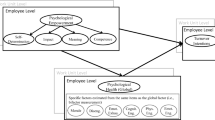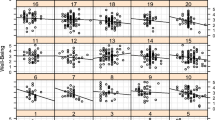Abstract
Many of the topics of interest in the social and behavior sciences are often hierarchical or multilevel in nature. These multiple levels (e.g., individual versus group) create problems for researchers related to the choice of measurement and analysis. Recent innovations in statistical analysis have made it possible to account for the hierarchical nature of observations. Therefore, in this article we begin with a review of multilevel analysis techniques and discuss advances that have been made in the social sciences using multilevel models. Next, we summarize contemporary research specific to the organizational psychology literature that uses multilevel analysis. Possible applications for industrial and personnel psychology are then discussed. Guidelines for determining if multilevel analysis is appropriate for a given applied research project are provided. We conclude with a summary and call for increased use of multilevel analysis in industrial and personnel psychology.
Similar content being viewed by others
References
Ackerman, P.L. (1988). Determinants of individual differences in skill learning. Journal of Experimental Psychology, 117, 288–318.
Ackerman, P.L. (1989). Individual differences in skill acquisition. In P.L. Ackerman, R.J. Sternberg & R. Glaser, (Eds.), Learning and individual differences: Advances in theory and research (pp. 165–217). New York: Freeman.
Aitkin, M., Anderson, D., & Hinde, J. (1981). Statistical modeling of data on teactrng styles. Journal of the Royal Statistical Society, Series A, 144, 419–461.
Aitkin, M., & Longford, N. (1986). Statistical modeling issues in school effectiveness studies. Journal of Royal Statistical Society, Series A, 149, 1–43.
Barr, R., & Dreeben, R. (1983). How schools work. Chicago: University of Chicago Press.
Borman, W.C., Dorsey, D., & Ackerman, L. (1992). Time-spent responses as time allocation strategies: Relations with sales performance in a stockbroker sample. Personnel Psychology, 45, 163–111.
Braun, H.I., Jones, D.H., Rubin, D.B., & Thayer, D.T. (1983). Empirical Bayes estimation of coefficients in the general linear model from data of deficient rank. Psychometrika, 489, 171–181.
Bryk, A.S., & Raudenbush, S.W. (1992). Hierarchical linear models. Newbury Park, CA: Sage Publications.
Burnstein, L. (1980). The analysis of multi-level data in educational research and evaluation. Review of Research in Education, 8, 158–233.
Cascio, W.F. (1991). Applied psychology in personnel management. (4th ed.). Englewood Cliffs, NJ: Prentice Hall.
Cleveland, J.N., Murphy, K.R., & Williams, R.E. (1989). Multiple uses of performance appraisal: Prevalence and correlates. Journal of Applied Psychology, 74, 130–1351.
Collins, L.M., & Horn, J.L. (Eds.) (1991). Best methods for the analysis of changes. Washington, D.C.: American Psychological Association.
Cronbach, L.J.(with the assistance of Deker, J. & Webb, N.) (1976). Research on classrooms and schools: Formulation of questions, design, and analysis. Occasional paper of the Stanford Evaluation Consortium, Stanford, CA.
Cronbach, L.J., & Webb, N. (1975). Between-and within-class effects in a reported aptitude-by-treatment interaction: Reanalysis of a study by G.L. Anderson. Journal of Educational Psychology, 6, 717–724.
Dansereau, F., Allutto, J.A., & Yammarino, F.J. (1984). Theory testing in organization behavior: The variant approach. Englewood Cliffs, NJ: Prentice Hall.
de Leeuw, J., & Kreft, I. (1986). Random coefficient models for multilevel analysis. Journal of Educational Statistics, 11, 57–85.
Early, P.C., & Britain, J. (1993). Cross-level analysis or organizations: Social resource management model. Research in Organizational Behavior, 15, 357–408.
Eyring, J.D., Johnson, D.S., & Francis, D.J. (1993). A cross-level units-of-analysis approach to individual differences in skill acquisition. Journal of Applied Psychology, 78, 805–814.
Florin, P., Giamartino, G.A., Kenny, D.A., & Wandersman, A. (1990). Levels of analysis and effects: Clarifying group influence and climate by separating individual and group effects. Journal of Applied Social Psychology, 20, 881–900.
Gatewood, R.D., & Feild, H.S. (1993). Human resource selection (3rd ed.). Chicago: Dryden Press.
George, J.M. (1990). Personality, affect, and behavior in groups. Journal of Applied Psychology, 75, 107–116.
George, J.M., & James, L.R. (1993). Personality affect, and behavior in groups revisited: Comment of aggregation, levels of analysis, and a recent application of within and between analysis. Journal of Applied Psychology, 78, 798–804.
Gerhart, B., & Milkovich, G. T. (1992). Employee compensation: Research and practice. In M.D. Dunnette and L.M. Hough (Eds.), Handbook of Industrial and Organizational Psychology (2nd ed.) (Vol. 3) (pp. 481–569). Palo Alto, CA: Consulting Psychologist Press.
Glick, W.H., & Roberts, K. (1984). Hypothesized interdependence, assumed independence. Academy of Management Review, 9, 722–735.
Goldstein, H.I. (1987). Multilevel models in educational and social research. London: Oxford University Press.
Gully, S.M. (1997). A cross-level analysis of the influences of feedback, cognitive ability and goal orientation on individual outcomes in a team training context. Paper presented at the annual conference of the Society for Industrial and Organizational Psychology, St. Louis, MO.
Guzzo, R.A., & Shea, G.P. (1992). Group performance and intergroup relations in organizations. In M.D. Dunnette and L.M. Hough (Eds.), Handbook of industrial and organizational psychology (2nd ed., Vol. 3; pp. 269–313). Palo Alto, CA: Consulting Psychologist Press.
Hackman, J.R. (1992). Group influences on individuals in organizations. In M.D. Dunnette and L.M. Hough (Eds.), Handbook of industrial and organizational psychology (2nd ed., Vol. 3; pp. 199–267). Palo Alto, CA: Consulting Psychologist Press.
House, R.J. (1991). The distribution and exercise of power in complex organizations: A meso theory. Leadership Quarterly, 2, 23–58.
James, L.R., Demaree, R.G., & Wolf, G. (1984). Estimating within-group intrarater reliability with and without response bias. Journal of Applied Psychology, 69, 85–98.
Kenny, D.A. (1996). The design and analysis of social interaction research. Annual Review of Psychology, 47, 59–86.
Kenny, D.A. & La Voie, L. (1985). Separating individual and group effects. Journal of Personality and Social Psychology, 48, 339–348.
Kenny, D.A., & Stigler, J. (1983). LEVEL: A FORTRAN program correlational analysis of group-individual data. Behavior Research Methods and Instrumentation, 15, 606.
Klein, K.J., Dansereau, F., & Hall, R.L. (1994). Levels issues in theory development, data collection, and analysis. Academy of Management Review, 19, 195–229.
Landy, F.J. (1989). Psychology of work behavior (4th ed.). Pacific Grove, CA: Brooks/Cole Publishing Company.
Lawler, E.E., III, & Jenkins, G.D., Jr. (1992). Strategic reward systems. In M.D. Dunnette and L.M. Hough (Eds.), Handbook of industrial and organizational psychology (2nd ed., Vol. 3; pp. 1009–1055). Palo Alto, CA: Consulting Psychologist Press.
Mason, W.M., & Wong, G.M. (1983). Contextual analysis through the multilevel linear model. In S. Leinhardt (Ed.), Sociological methodology (pp. 72–103). San Francisco: Jossey-Bass.
Mathieu, J.E. (1991). A cross-level nonrecursive model of the antecedents of organizational commitment and satisfaction. Journal of Applied Psychology, 76, 607–618.
Mathieu, J.E., & Kohler, S.S. (1990). A cross-level examination of group absence: Influences on individual absence. Journal of Applied Psychology, 75, 217–220.
Mossholder, K.W., & Bedeian, A.G. (1983). Cross-level inference in organizational research: Perspectives on interpretation and application. Academy of Management Review, 8, 547–558.
Ostroff, C. (1992). The relationship between satisfaction, attitudes and performance: An organizational level analysis. Journal of Applied Psychology, 77, 963–974.
Raffe, D. (1991). Assessing the impact of a decentralized initiative: The British technical and vocational initiative. In S.W. Raudenbush & J.D. Williams (Eds.), Schools, classrooms, and pupils: International studies of schooling from a multilevel perspective (pp. 149–166). Orlando, FL: Academic Press.
Raudenbush, S.W. (1988). Applications of hierarchical linear models in educational research: A review. Journal of Educational Statistics, 13, 85–116.
Raudenbush, S.W., & Bryk, A.S. (1986). A hierarchical model for studying school effects. Sociology of Education, 59, 1–17.
Rousseau, D.M. (1985). Issues of level in organizational research: Multilevel and cross-level perspectives. Research in Organizational Behavior, 7, 1–37.
Rubin, D.B. (1980). Using empirical Bayes techniques in the Law School Validity Studies. Journal of the American Statistical Association, 75, 801–827.
Schneider, B. (1987). The people make the place. Personnel Psychology, 40, 437–453.
Sneizek, J.A., & Henry, R.A. (1990). Revision, weighting, and commitment in consensus group judgement. Organizational Behavior and Human Decision Processes, 45, 66–84.
Tate, R.L., & Hokanson, J.E. (1993). Analyzing individual status and change with hierarchical linear models: Illustration with depression in college students. Journal of Personality, 61, 181–206.
Thomas, J.B., Shankster, L.J., & Mathieu, J.E. (1994). Antecedents to organizational issue interpretation: The roles of single-level, cross-level, and content cues. Academy of Management Journal, 37, 1252–1284.
Vancouver, J.B., Millsap, R.E., & Peters, P.A. (1994). Multilevel analysis of organizational goal congruence. Journal of Applied Psychology, 79, 666–679.
Yammarino, F.J., & Markham, S.E. (1992). On the application of within and between analysis: Are absence and affect really group-based phenomena? Journal of Applied Psychology, 77, 168–176.
Yukl, G., & Van Fleet, D. D. (1992). Theory and research on leadership in organizations. In M.D. Dunnette and L.M. Hough (Eds.), Handbook of industrial and organizational psychology (2nd ed., Vol. 3; pp. 147–197). Palo Alto, CA: Consulting Psychologist Press.
Author information
Authors and Affiliations
Rights and permissions
About this article
Cite this article
Gilbert, J.A., Shultz, K.S. Multilevel modeling in industrial and personnel psychology. Curr Psychol 17, 287–300 (1998). https://doi.org/10.1007/s12144-998-1012-9
Issue Date:
DOI: https://doi.org/10.1007/s12144-998-1012-9




